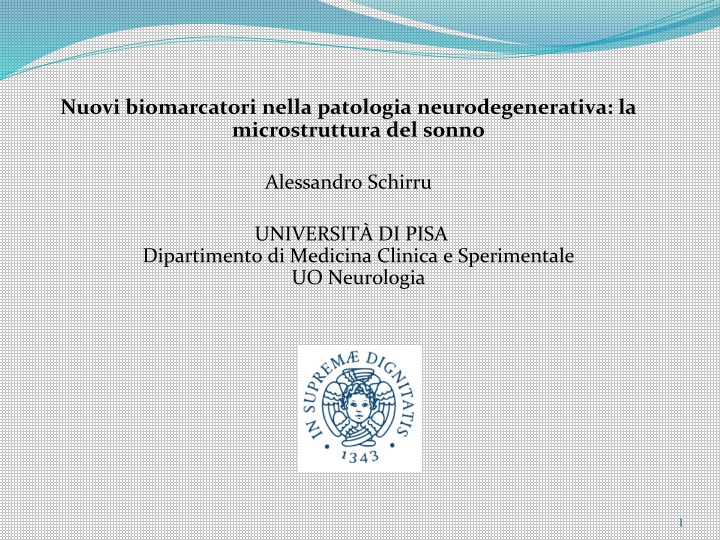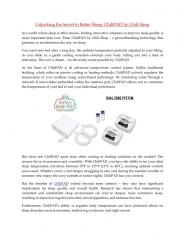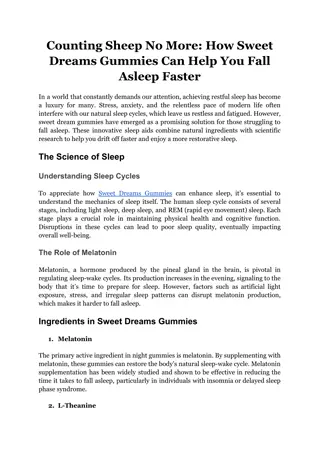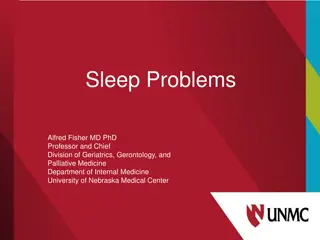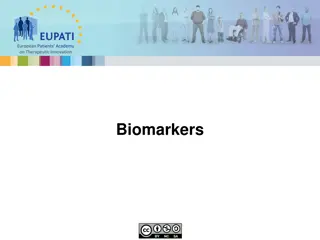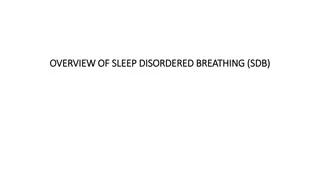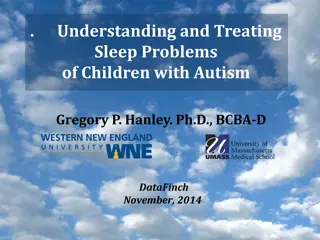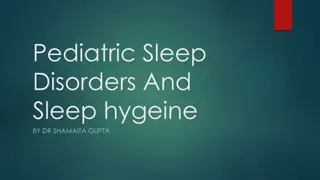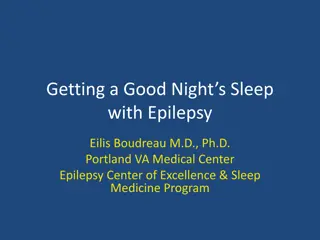New Biomarkers in Neurodegenerative Pathology: Sleep Microstructure
Mild Cognitive Impairment (MCI) is an intermediate cognitive stage, often a precursor to dementia. This study explores the relationship between sleep patterns and MCI progression in elderly individuals. It compares sleep characteristics between MCI patients and cognitively healthy elderly subjects to identify potential biomarkers for early detection and monitoring of neurodegenerative diseases.
Download Presentation

Please find below an Image/Link to download the presentation.
The content on the website is provided AS IS for your information and personal use only. It may not be sold, licensed, or shared on other websites without obtaining consent from the author.If you encounter any issues during the download, it is possible that the publisher has removed the file from their server.
You are allowed to download the files provided on this website for personal or commercial use, subject to the condition that they are used lawfully. All files are the property of their respective owners.
The content on the website is provided AS IS for your information and personal use only. It may not be sold, licensed, or shared on other websites without obtaining consent from the author.
E N D
Presentation Transcript
Nuovi biomarcatori nella patologia neurodegenerativa: la microstruttura del sonno Alessandro Schirru UNIVERSIT DI PISA Dipartimento di Medicina Clinica e Sperimentale UO Neurologia 1
Mild Cognitive Impairment Mild Cognitive Impairment has been defined as an intermediate stage of cognitive function between normal aging and dementia Healthy Aging Mild Cognitive Impairment Progression from MCI to dementia is time- dependent, and may be as high as 60-65% Dementia The conversion rate is usually believed to be 10 25% per year, and a higher conversion rate may be observed within the initial 2 3 years (Jack et al., 2005; Busse et al., 2006).
Materials and Methods 19 Subjects with amnestic MCI (aMCI) : (9F/10M; mean age 72.9 5.7 years). After 2 years of follow up were divided into MCI converters and non converters. 11 healthy elderly (5F/6M; mean age 69.2 12.6 years) Home-based PSG sleep recording eight EEG channels electrooculograms submental surface electromyogram (EMG), electrocardiogram (EKG), thermistor for nasal and oral airflow, thoracic and abdominal respiratory efforts strain gauges, finger pulse oximeter, digital microphone, left and right tibialis anterior EMG. 4
Results: MCI vs HE HE n=11 MCI n=19 Mann-Whitney U test, p Total sleep time, min 414.5 64.8 361.9 70.7 N.S. Wakefulness after sleep onset, min 114.9 69.0 109. 55.2 N.S. Awakenings, n/h 5.6 1.3 5.6 4.2 N.S. REM latency, min 124.0 54.5 148.3 111.9 N.S. Sleep stage N1, % 6.7 2.4 10.9 6.1 N.S. Sleep stage N2, % 45.8 6.3 45.4 11.0 N.S. Sleep stage N3, % 23.5 4.8 26.6 11.3 N.S. Sleep stage REM, % 24.1 4.6 17.0 7.3 0.003 REM periods, n 10.0 8.4 7.5 4.0 N.S. Stage shifts, n/h 15.4 2.7 15.0 7.2 N.S. 5
Results: MCI vs HE HE MCI Mann Whitney U test, p N.S. N.S. <0.05 N.S. <0.05 N.S. <0.05 <0.05 <0.05 <0.05 N.S. N.S. N.S. N.S. N.S. N.S. N.S. Significant reduction of CAP rate and CAP slow components (A1 index) in MCI compared to cognitively intact elderly subjects. A2 and A3 subtypes (arousal- related fast components) increased as a percentage Total CAP rate, % CAP rate N1, % CAP rate N2, % CAP rate N3, % A1, % A2, % A3, % A2+A3, % A1 Index, n/h A2 Index, n/h A3 Index, n/h A1 duration, sec A2 duration, sec A3 duration, sec B duration, s CAP sequences, n Sequence duration, s 48.5 6.7 26.2 15.7 43.5 7.1 64.5 12.1 59.6 8.5 17.0 6.2 20.9 9.5 40.4 7,9 39.0 6.5 12.6 5.3 13.0 5.9 6.8 3.0 9.5 2.8 11.0 4.0 21.7 7,2 41.5 8.9 225.4 36.8 39.4 15.2 22.2 19.4 32.7 16.3 54.5 17.4 50.4 12.7 19.5 5.1 32.6 14.2 52,1 6,4 28.1 10.9 8.3 4.1 17.7 13.0 5.7 3.2 10.4 4.1 10.6 4.8 23.2 3.0 32.9 10.0 213.5 64.3 6
Results: MCI converters vs non converters Non Converters Converters Mann Whitney N=8 N=11 U test, p N.S. Total sleep time, min Wakefulness after sleep onset, min Awakenings, n/h REM latency, min Sleep stage N1, % Sleep stage N2, % Sleep stage N3, % Sleep stage R, % REM periods, n Stage shifts, n/h 360.5 80.4 362.9 69.9 99.6 71.0 117.3 133.7 N.S. 4.1 4.4 66.5 85.2 10.9 6.5 42.7 13.4 29.8 10.6 16.7 8.1 7.0 3.5 12.8 7.3 6.5 4.0 214.1 212.7 11.0 6.2 47.5 9.2 24.3 11.7 17.2 7.1 9.0 6.1 16.6 7.0 N.S. N.S. N.S. N.S. N.S. N.S. N.S. N.S. 7
Results: MCI converters vs non converters Non Converters Converters Mann Whitney U test, p N=8 N=11 Total CAP rate, % CAP rate in N1,% CAP rate in N2,% CAP rate in N3,% A1, % A2, % A3, % A2+A3, % A1 Index A2 Index A3 Index A1 duration, sec A2 duration, sec A3 duration, sec B duration, s CAP sequences, n Sequence duration, s 49.1 8.3 35.0 21.9 42.7 13.1 60.1 11.8 48.6 9.2 14.0 4.5 37.5 9.1 51.5 7.0 33.6 6.9 9.5.4 3.5 25.5 9.9 6.45 0.8 8.3 1.0 8.2 12.9 22.3 1.9 38.8 8.6 232.8 51.3 32.4 15.4 12.9 10.8 25.5 14.9 50.4 20.2 51.8.4 15 19.3 6.5 29.0 16.5 48.3 11.5 24.3 11.9 7.5 4.5 12.0 7 8.3 1.7 11.9 4.9 12.3 5.3 23.9 3.5 28.6 8.9 199.5 71.3 <0.05 N.S. N.S. N.S N.S. N.S. N.S. N.S. <0.05 N.S. <0.05 N.S. N.S. N.S. N.S. N.S. N.S. 8
Discussion Significant differences emerge from sleep microstructure. The converter MCI show thus a profile more similar to AD than the non-converter. showing a reduction in CAP rate, A1 and A3 index. Positive influence of A1 subtypes on cognitive functioning, opposed to a worse performance predicted by A2 and A3 subtypes and CAP rate referred to both global sleep and slow-wave sleep. CAP A1 subtypes are mainly composed by slow waves, feature that suggest them as reliable candidates for a major role in these sleep-related cognitive processes (Ferini Strambi et al., 2013; Ferri et al., 2008; Ferri et al., 2010; Arico et al., 2010; Bruni et al., 2012). Also when considering a more general parameter, such as CAP rate, a correlation between decreased values and cognitive functioning has been demonstrated. 9
Conclusions NREM sleep microstructure is significantly disrupted in MCI patients vs healthy elderly Differences among MCI converters and non- converters Longitudinal effect of sleep microstructure changes Potential biomarker of AD evolution 12
